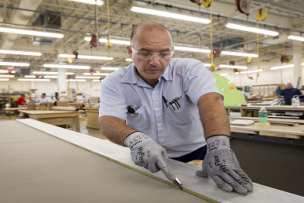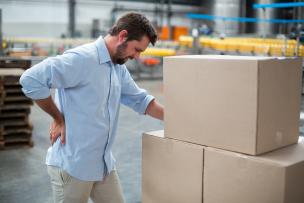Here’s a look at what leading research says about back braces.
Lower back pain is one of the top health complaints in the workplace, affecting people in a variety of occupations, including construction, manufacturing, office work, healthcare, and shipping and receiving. Musculoskeletal disorders, particularly lower back pain and sciatica, account for nearly a third of all injury and illness and are a leading cause of disabling injury in the workplace—a big part of the $15 billion in injuries caused by overexertion annually.
So it may come as no surprise that both employers and workers will try different treatments to prevent and address lower back pain. One of the most popular choices has been to have workers wear a back brace or a “back belt,” which are designed to provide additional truncal support while limiting a range of motion.
The goal with back braces has been to provide a single solution that will work for any worker—whether it’s a Transportation Security Administration employee who lifts luggage, a metalworker leaning over a spindle, a nurse moving a heavy patient or an administrative assistant sitting at a desk all day.
A Lack of Evidence
There’s no sufficient evidence, however, indicating these back braces actually work, says Ming-Lun Lu, Ph.D., a research ergonomist at the National Institute for Occupational Safety and Health (NIOSH) at the Centers for Disease Control and Prevention.
“Some laboratory studies suggest back braces may reduce spinal loading and trunk flexibility so that you don’t overflex, but there’s nothing out there showing that wearing these braces prevents back pain,” says Lu. “There are even some complaints the braces cause discomfort and sweating, such as baggage handlers at airports who have tried them.”
Lu’s observations echo the findings of a study published in the prestigious Journal of the American Medical Association, which also concluded that back braces provided little prevention. The study was based on nearly 14,000 employees who handled materials. Researchers conducted interviews with workers and evaluated the incidence rate of workers’ back injuries, compensation claims and self-reported lower back pain.
The results showed that back braces did little in reducing back pain or injury.
Back Pain Is Part of a Larger Issue in the Workplace
“We haven’t done a good job managing back pain in the workplace in the past 20 to 30 years,” says Lu.
“We don’t have any nationwide ergonomic standards to address this issue, so it has to be addressed at the company level. It’s up to employers to create programs and invest in lifting-assist devices so that lifting and other similar physical movement can be automated. This will protect workers from injury.”
For example, Lu says, some hospitals and airports—two sectors with high rates of heavy lifting and reports of back problems—have “zero-lifting” policies to protect employees. Patients or materials are moved using machinery, such as wheeled lifts that a nurse operates or vacuum lifts that a worker controls.
“This is where you see the industry really booming,” Lu says. “The future is in developing technology that does the heavy lifting. That’s when you’ll really start to see back pain complaints go down.”
Lower Back Pain Treatment Alternatives
With the knowledge that braces don’t work comes responsibility. Tasks need to be redesigned to reduce repeated lifting, bending and twisting on the job.
NIOSH recommends redesigning tasks so the load is closer to the body and between shoulder and knuckle height, and so there’s no twisting while lifting. If possible, when moving loads, particularly heavy ones, use gravity: ramps, chutes, pulleys, hoists and hand trucks.
When moving heavy materials, remember that pushing is better than pulling, which only increases the risk of strain and injury. Pushing, however, applies large muscle groups to exert force on an object. Correct posture is also important: Keep the head upright and not turned, maintain the natural curve of the spine and keep the shoulders relaxed and knees slightly bent, with elbows close to the body. Lifting with the legs may help reduce back strain, but this is not a guarantee. When lifting manually, place materials about midthigh to midchest and maintain a neutral spine. Bend at the knees, not the waist, to maintain proper spine alignment and reduce the risk of strain or injury.
What are you doing to make sure your workers aren’t overexerting their backs?





Talk to Us!
I am 86 years old; my back pain is causing me to not only walk bent over but to avoid walking at all. Is there any brace that can help me stand up and walk without experiencing pain or, is this condition just part of being "ancient"?
66I,m not sure what # is the one that I need to call
91Leave a reply
Your email address will not be published. Required fields are marked *